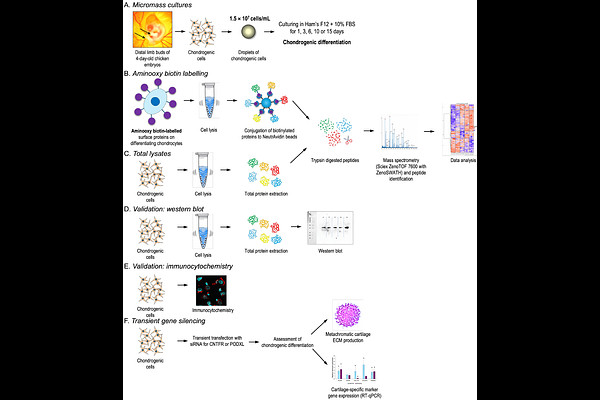Podocalyxin and ciliary neurotrophic factor receptor are novel components of the surfaceome of chondrogenic cells

Podocalyxin and ciliary neurotrophic factor receptor are novel components of the surfaceome of chondrogenic cells
Kovacs, P.; Brazda, P.; Hajdu, T.; Harsanyi, B.; Juhasz, K. Z.; Takacs, R. A.; Judit, V.; Wang, Z.; Coveney, C.; Boocock, D. J.; Matta, C.
AbstractChondrogenesis, the process driving cartilage formation, is critical for advancing strategies in cartilage repair and mitigating osteoarthritis (OA) management. In this study, we present the first comprehensive quantitative analysis of the surfaceome of chondrogenic cells using a well-established in vitro chondrogenic model. By employing sialic acid-targeted glycocapture enrichment of surface proteins coupled with high-throughput shotgun mass spectrometry, we identified podocalyxin (PODXL) and ciliary neurotrophic factor receptor (CNTFR) as novel components of the chondrogenic cell surfaceome. The expression and function of CNTFR and PODXL on chondrogenic cells were validated using western blotting, immunocytochemistry and transient gene silencing. Notably, silencing of CNTFR and PODXL revealed divergent transcriptional effects on COL1A1, a key marker of fibrocartilage and matrix quality, indicating opposing roles in regulating extracellular matrix composition and chondrocyte identity. The identification of PODXL and CNTFR provides new insights into the molecular mechanisms underlying chondrogenesis. The expression of CNTFR on chondrogenic cells suggests a potential role for neurotrophic factors in chondrogenesis and cartilage repair strategies. PODXL, a sialomucin linked to cell-matrix interactions and migration, is potentially involved in maintaining early chondrocyte phenotypes and mediating chondrogenic signals. Altered PODXL and CNTFR in synovial fluid or serum could represent diagnostic biomarkers for early OA, enabling minimally invasive monitoring of cartilage degeneration. Their expression could also be leveraged to monitor disease progression and evaluate therapeutic efficacy. Furthermore, these proteins represent promising targets for OA treatment by modulating their associated signalling pathways to enhance cartilage repair. The detailed profiling of the chondrogenic cell surfaceome establishes a foundation for mechanistically informed biomarkers and pathway-specific therapies to restore cartilage homeostasis in cartilage-related disorders such as OA.